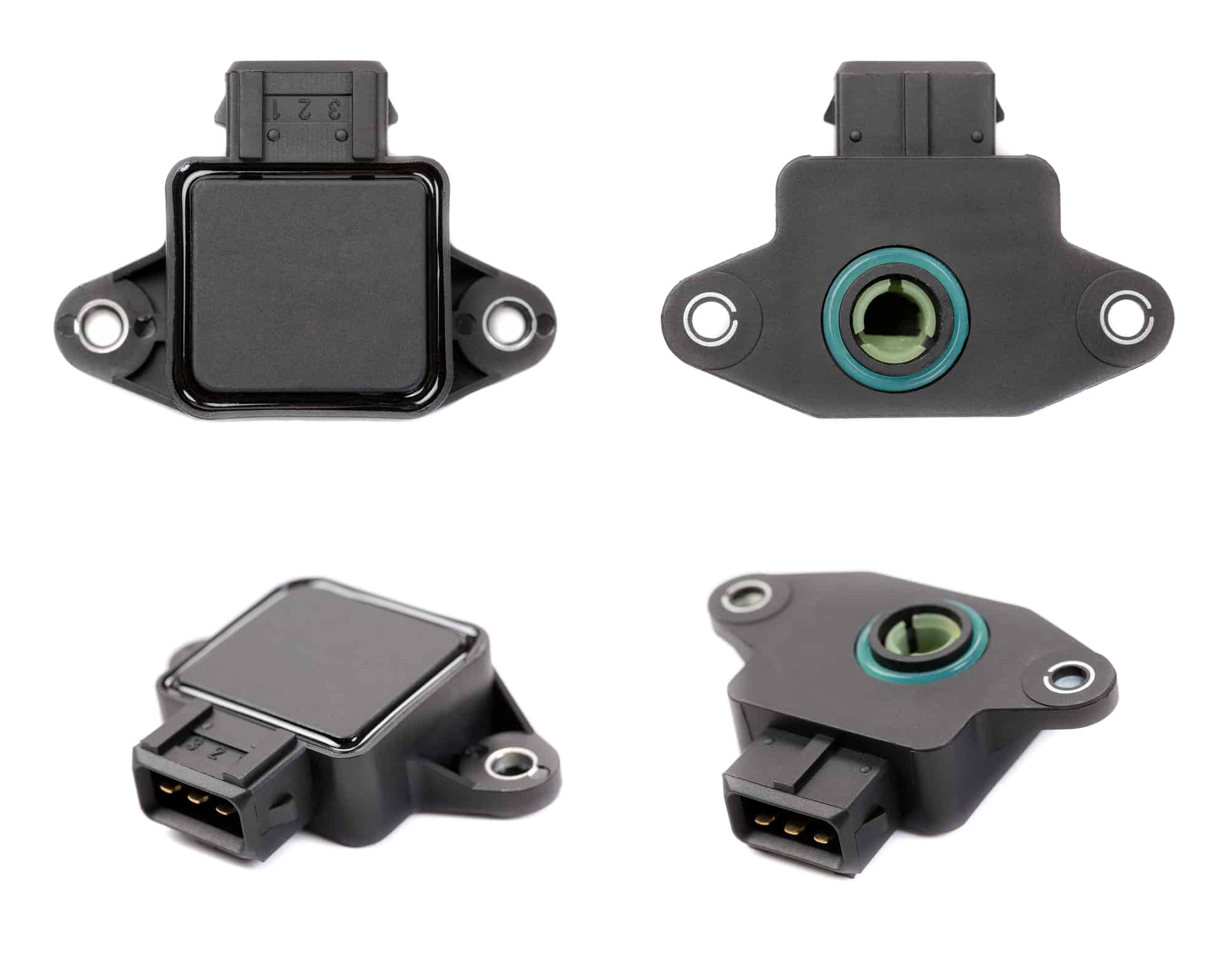The Throttle Position Sensor (also known as TP sensor or simply TPS) is the sensor that is connected to the throttle body of your engine that keeps track of how open the throttle body is.
The symptoms of a bad throttle position sensor include poor fuel economy, lack of engine power, a rough engine when idling, lack of power when accelerating, and engine misfires.
The throttle position sensor reports the throttle aperture to the ECU and this information is vital not only for the fuel delivery control but also for the automatic transmission.
This sensor should not be confused with the Accelerator Pedal Position Sensor (APP sensor), they have a similar goal but are not used for the same purpose.
In this article I’ll explain how a throttle position sensor works, the symptoms of a bad throttle position sensor and how to diagnose and fix a TPS when it fails.
10 Symptoms Of A Bad Throttle Position Sensor
The data that a throttle position sensor (TPS) reports back to the ECU is vital for fuel delivery control as well as automatic transmission shift controller. If there is a problem with the TPS, then you are going to experience problems with how the engine performs.
The most common symptoms of a bad throttle position sensor are centered around a lack of power, especially when accelerating along with poor fuel economy. This is because the ECU does not know exactly how hard you are pressing on the accelerator if the TPS readings are not accurate.
The most common symptoms of a bad throttle position sensor are:
Symptom 1: Check Engine Light On
Due to its crucial role in powertrain management, expect the check engine light to come on after a few driving cycles if the throttle position sensor is faulty.
Symptom 2: Poor fuel economy
Without proper information coming from the TPS the ECU won’t be able to operate efficiently and thus, a noticeable decrease in fuel economy will be evident. This is because the ECU will not know how hard you are pressing on the accelerator if it does not know the aperture of the throttle body flap.
Symptom 3: Rough Engine idle
Depending on the vehicle year and maker, the ECU may not compensate for this failure during idle. This might cause a rough idle or even an engine dying occasionally while idling.
Symptom 4: Intermittent surges in engine performance
Due to its inherent electrical design, the TP sensor may suffer from internal wear especially in certain zones where it works the most. If that’s the case, you will feel engine hesitation only at specific throttle positions causing intermittent surges in performance.
Symptom 5: Engine hesitation during acceleration
A bad throttle position sensor will make it very hard for the ECU to calculate the necessary amount of fuel during sudden acceleration. In such a scenario, the ECU will sense the drop in engine vacuum first and then using other sensor data (the MAP and MAF sensors) will decide if more fuel is required. That process could take half a second to a second, more than enough to perceive a lack of acceleration. This condition will be worse under wide open throttle acceleration.
Symptom 6: Engine misfires
A faulty or damaged TP sensor may be the cause of engine misfires, especially during acceleration. This is down to a lack of fuel being fed into the combustion chamber of the cylinder when needed.
Symptom 7: Lack of power
There are others systems affected by a bad or deficient TPS. One of them the automatic transmission. Depending on the year and maker of your vehicle you may expect the transmission to lock the gearbox in one position causing a huge drop in acceleration performance as you may be in too high or too low a gear for the speed you wish to travel at.
Symptom 8: Unexpected transmission shifts
Depending on the TP sensor condition (damaged or deficient) you may find your transmission doing upshifts or downshifts unexpectedly. This is because on a basic level, the transmission changes gear when you change the throttle body aperture (press harder on the throttle, or let your foot off). If the throttle body sensor is not relaying accurate information then the transmission is going to select the wrong gear.
Symptom 9: Gas smell from exhaust pipe
The failure to deliver the exact amount of fuel to the engine with the added issue of a locked transmission could cause a noticeable gas smell coming from your exhaust pipe. This is caused by an incorrect fuel-to-air ratio, causing unburnt fuel to pass into the exhaust system. This can also damage the catalytic converter.
Symptom 10: Loss of overdrive
As a direct consequence of a faulty TP sensor expect a reduced operation of your transmission shifts, including the OD mode.
what does a throttle position sensor do?
The throttle position sensor is attached to the throttle body and its job is to monitor the position of the throttle and how much air is entering the engine at any given time.
The throttle body is responsible for controlling the amount of air that enters the engine. As you push down on the accelerator, the throttle body flap opens more to let in more air. The throttle position sensor keeps track of the position of the throttle body flap and sends this information back to the ECU.
Using this information, the ECU can calculate how much fuel is necessary to match the amount of air entering the engine and adjust the fuel output from the injectors accordingly.
How Does A Throttle Position Sensor Work?
The vast majority of throttle position sensors share a 3-wire design. However, depending on your vehicle manufacturer, you may have a 4-wire and even in rare cases, a 5-wire TP sensor.

Internally, all TP sensors use a potentiometer that measures the throttle flap position. Potentiometers are by definition a special kind of variable resistor composed of a resistive material and a rotating contact (often called “wiper”). Because of its electrical design, throttle position sensors need at least 3 wires: one for the reference voltage, one for the returning voltage and one for the ground.
Less common sensors like the 4-wire and 5-wire TPS include internal switches that report idle position and/or wide open throttle position.

Every time you turn the ignition on, the ECU sends a 5V reference voltage to all its analog sensors.
In the case of TPS, the reference voltage is received by one of its terminals, passed through the potentiometer resistive material, and then goes out by another terminal back to the ECU.
The third terminal (ground) completes the electrical circuit. The electronic control unit use the returning signal from the sensor to determine the actual throttle position, usually calculated in the form of aperture percentage or angle.
How much does it cost to replace a bad throttle position sensor?
You can expect to pay anywhere from $30 to $60 dollars to buy a new throttle position sensor for your car or truck.
If you are planning on replacing it yourself then this is a fairly cheap fix. Of course, you are going to have to have the right tools for the job and a good quality diagnostic code reader is a must.
If you are going to leave it to a mechanic to repair then you can expect to pay $300-$500. This is because there can be a large amount of labor involved in accessing and replacing the sensor.
How Do You Diagnose A Bad Throttle Position Sensor?
For the purpose of this article, it’s assumed that you have a basic knowledge of safety precautions while working on your vehicle.
The throttle position sensor is one of the easiest components to diagnose. You will only need the following tools:
- OBD2 Code Reader
- Digital multimeter (DMM)
- However, if you are looking for more convenience you can also use the following tools:
- Magnifying glasses
- Analog multimeter (VOM)
- Automotive diagnostic scanner with live data capabilities
A professional grade automotive scanner with live data graphing capabilities is not essential for testing the TP sensor, but certainly would speed up the process no matter what kind of sensor is installed.
Always refer to the appropriate OEM literature when possible. Original manufacturer diagnostic procedures should always take precedence over a generic workflow.
That said, let’s start the diagnostic process!
1. Preliminary steps
Recommended tools: OBD2 Code Reader
Optional tools: none
> Data trouble codes: using an OBD2 code reader take note of any DTC present in the ECU memory. For doing so you only need to connect your code reader and turn the ignition key on (engine off), a state usually known as KOEO.
> Data trouble codes clear: now that you know what codes were stored into memory you need to clear them. This is usually done selecting “clear codes” in your tool.
> Driving cycle: disconnect your OBD2 code reader and start the engine, this state is commonly known as KOER (Key On Engine Running). If the Check Engine Light turns on then stop the engine and continue with the diagnostic. If the Check Engine Light remains off then drive the vehicle for 5 to 10 minutes. If the light remains off you may have an intermittent problem. If the light lit during your driving cycle then continue with the diagnostic process.
IMPORTANT: The following tests assume that the TP sensor harness is already unplugged, refer to “how to replace” section if you have any doubt.
2. Visual Inspection
Recommended tools: none
Optional tools: magnifying glasses
> Sensor wiring: perform a meticulous visual inspection of TP sensor wiring. Look for burnt, damaged, corroded or deteriorated wires. Pay special attention to possible shorts to ground or open circuits produced by a faulty insulation.
> Sensor harness connector: similar than before, perform a exhaustive visual inspection of TP sensor connector. Ensure that the ignition key is switched off and unplug the TP sensor harness connector. Look for bent terminal pins, loosely connections, corrosion or any other possible indication of a bad connection.
Fix any wiring problem before continuing.
3. Electrical Tests
Recommended tools: digital multimeter (DMM)
Optional tools: analog multimeter (VOM), manufacturer literature.
> Sensor continuity: turn the digital multimeter dial to “continuity” test mode. Now use the multimeter probes to measure the continuity between the sensor terminals located at each end. You should hear the distinctive “beep” in your DMM indicating good continuity. Now place one probe in the center terminal of the sensor and the other in one of the farthest sensor terminals. Again, you should have good continuity. Repeat the procedure keeping the center probe in place and touching the remaining terminal with the other, one more time you should have continuity. An open circuit during this test would be an indication of a bad throttle position sensor.
> Sensor internal resistance: this test assumes that you already located an OEM literature containing the exact specification of your TP internal resistance. If that’s the case, turn your digital multimeter dial to “resistance” mode in an appropriate range depending on the expected TP internal resistance value. Measure the electrical resistance between the two farthest terminals. Replace the sensor if not within the expected value.
> Reference voltage: the prior tests were conducted with the ignition key off, directly on the TPS. In order to measure the reference voltage, you will need to enter in KOEO mode (Key On Engine Off) and turn the digital multimeter dial to “voltage” test mode. Now place one multimeter probe in a known ground (battery negative is a good one) and the other probe tip in one of the farthest terminals of the TP sensor wiring harness. If there is no voltage then keep the ground probe and touch the opposite terminal on the sensor harness. One of the outer terminals should read near 5V. That’s the nominal reference voltage coming directly from the ECU. If neither terminal shows voltage (or is below 4V) then you must check the wire continuity and resistance starting from each terminal all the way to the ECU. On the other hand, if you do find a terminal receiving 4.5V or more, mark it as the VREF wire.
> Ground test: this test assumes that you found a good reference voltage coming from the ECU. Once again, enter in KOEO mode (Key On Engine Off) turn the digital multimeter dial to “voltage” test mode and place one probe tip on each of the farthest harness terminals. You should read the same (or about the same) voltage than the previous test. A difference greater than 10% may indicate a poor ground. If that’s the case, you must check the electrical resistance from the harness terminal all the way down to the ECU.
> Sensor internal wear: this test requires using an analog multimeter instead of a digital one. Place one multitester probe tip in the center terminal of the TP sensor and the other in the corresponding “reference voltage” terminal on the sensor. Slowly open the throttle flap while watching the VOM pointer (needle) moving. The expected behavior is a needle that moves steadily clockwise. If during the test the multimeter pointer stops (while still opening the throttle flap) or it drops counter-clockwise then you have a bad throttle position sensor and should be replaced.
4. Scan Tool Tests
Recommended tools: automotive scan tool with live data capabilities.
Optional tools: a professional automotive diagnostic scanner with live data graphing ability.
> Throttle Position Sensor live test: using an automotive diagnostic scanner you can perform a TPS health test similar to the “sensor internal wear” test. Connect your scan tool and enter in KOEO mode (Key On Engine Off). Select live data and lock the TP sensor on screen. If your scanner has live data graphing ability use it. Press the accelerator pedal very slowly while looking at the scanner display. You should see a straight line with a positive slope on the screen as you press the pedal. Any abrupt change in the line during the test is an indication of a bad throttle position sensor. On some vehicle models, you may see a negative slope line. The test principle is the same, any sudden change in the slope is enough to replace the sensor.
> Idle Switch / WOT Switch: as mentioned earlier some TP sensor designs use 4 or more wires. The additional wires are there for the idle and/or wide open throttle switches. Using you automotive scanner you can easily check their status. Enter in KOEO mode (Key On Engine Off) and select live data on your scanner. Look for the idle switch and WOT switch. Sometimes they are simply named “Idle” or “wot” followed by its status “ON / OFF”. Once you find them check that the idle switch is working changing from “ON” to “OFF” when you press the pedal. Similarly, test the WOT switch pressing the pedal until it reads “ON”. If either of the switches is not working as expected, you must check the OEM literature and find out if they can be calibrated. Follow OEM instructions as necessary. Replace the TP sensor in case no manual calibration is available. Please notice that many 3-wire TP sensors show the idle and WOT parameters in the scanner live data. That’s because the ECU is simulating the switching behavior of a 4-wire design. Always refer to OEM literature when in doubt about a possible TP sensor calibration.
How Do You Replace A Bad Throttle Position Sensor?
The TP sensor is usually located in the throttle body as an independent sensor, but depending on the engine design, sometimes the TPS may be part of the Electronic Throttle Control (ETC). This section will assume the first scenario, an independent TP sensor.
Recommended tools: OBD2 Code Reader, safety glasses, mechanics gloves, appropriate screwdriver and/or wrench, proper illumination (LED flashlight),
Optional tools: none
- Preliminary steps: ensure that the ignition switch is off and then disconnect the vehicle battery. Detaching the negative terminal is usually enough.
- Remove TP sensor connector: this step may be tricky in some models. Generally speaking, the traditional 3-wire sensor has a plastic tab that you should push down while you pull out the harness. But in many cases, there is a small security clip (sometimes plastic, sometimes metallic) that must be removed first using an adequate screwdriver.
- Remove TP sensor mounting screws: most throttle position sensors use two mounting screws. It’s not uncommon to use TORX type screws for this sensor.
- Install the new TP sensor: retire the old sensor and then install the new one. Double-check that you’re using the adequate part number.
- Adjust the new sensor: mount sensor screws and adjust the sensor position if necessary. You will need the OEM literature in case any calibration is needed.
- Reconnect sensor and battery: once you are done, reconnect the sensor (don’t forget security clips) and then the battery terminal.
- Clear DTC memory: using the OBD2 code reader clear the ECU memory to prevent any false code been stored. You will need entering in KOEO mode for doing so.
- Perform driving cycle: once you are done, drive the vehicle for more than 10 minutes. Try to accelerate as you would normally do.











I recently noticed my car struggling with acceleration and experiencing occasional engine misfires, especially under heavy acceleration. Considering these symptoms, could this indicate a failing throttle position sensor, and if so, what steps should I take to confirm it’s the TPS before considering a replacement?
I’ve been noticing some erratic behavior from my car, especially rough idling and a decrease in fuel efficiency. Could this be related to a problem with my throttle position sensor?